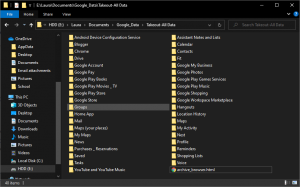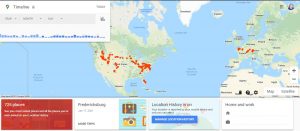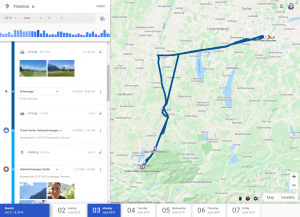Google, the Insidious Steward of Memories
by Laura Treider | March 12, 2021
All those cookies are bad for you
If you are a regular reader of this blog or if you take an interest in the use of data in our modern economy, you are aware that most companies you interact with digitally online or via apps on your phone track as much of your activity as possible. These companies frequently sell your data to brokers, or, while not technically selling it, work with advertisers to monetize your data by tailoring ads to serve you. Proponents of this scheme argue it’s good for consumers and everyone is happier seeing ads tailored for their interests. Privacy advocates are more skeptical and argue you should delete your data to avoid staying in a filter bubble and to prevent any other uses of your data that might not be to your benefit. Choosing to err on the side of privacy, I decided to see what data Google has about me and see how easy it is to delete it.
How to view and download your data
If you’re logged in to a chrome browser, seeing what data Google has about you is fairly simple; the details of how to accomplish it are here. Google has a data and personalization landing page that lets you view your tracked activity and control “personalization settings”, Google’s euphemism for how much they are tracking your activity. From this landing page, I was able to click through to a link to Google Takeout, their cheekily named platform for downloading all the information linked to your account. I chose to download everything possible. It took 10 hours before my download was ready and I received an email with 23 links. 22 of them were 2GB zipped files and a 6GB .mbox mail file containing emails since 2006. (I’m not an email deleter.)
What data does Google have about me?
While I was going through the downloads, I became overwhelmed by the sheer number of folders relating to different products, 40 in all. After I unzipped the 22 files and put them together on my hard drive, I found that Google includes an archive_browser.html file that helps you navigate the file structure. Google isn’t just holding data about my web browsing activity and search history. I was surprised to learn that I had more than 25,000 photos uploaded to Google’s servers. These weren’t from my android phone, either. They were from my camera. At some point in my data life, I must have chosen to upload 25,000 photos to the cloud, but I don’t remember having done that. There were also 48 videos included, the entirety of my YouTube channel I had set up 15 years ago while living in England and sharing memories of my newborn son with family in the US.

Interestingly, not included in my Takeout was my Ad Settings. I had to navigate to those via the online “Data & personalization” hub. I was able to see all the things that Google thinks I’m interested in. Some of them made sense: “Dogs,” “TV Comedies,” “Computers and Electronics,” and “Cooking and Recipes.” Others were a little more perplexing: “Nagoya,” “Legal Education,” and “Parental Status: Not A Parent.” (Sorry, son, I must not Google how to parent you enough.) As an aside, a great ice breaker for virtual dates during this pandemic would be to share each other’s ad personalization data with each other.
In addition to the files I had given Google and the ad settings Google was predicting for me, Google also has 96 MB of location data for me, 12 MB of search history spanning the last 18 months, and another 11 MB of browsing history spanning the past 5 months. Here’s where I got distracted: Google gives you your location data in the form of a JSON file. If you want to turn that JSON file into something viewable in map form and you’re programmatically inclined, I recommend this GitHub repo.
The Google location data rabbit hole
But Google’s online viewer for showing you your location history is engrossing. You land on a map with a bunch of markers representing places you have visited and lived at with some fun badges to encourage you to explore.

I looked at my data from Boise, the previous city I lived in, and randomly clicked dots. Each location came with a flood of memories about when I had gone there and why.

I went back in time to when I knew I had gone on a vacation to Germany. Clicking through the days was like looking at a scrapbook Google assembled for me. One of the days is shown below. I had traveled from our hotel in Munich to the Neuschwanstein and Hohenschwangau castles. My travel path was there, complete with the stop I had made in Trauchgau to air up a leaky tire. Not only was my route there, I could dig through the photos I took on my mobile phone at each stop. What a gift!

The verdict:
According to a recent survey by the US census, only 89% of households has a computer. That’s potentially more than 30 million people who may have smart phones but no computer. So not all users of Google products have the luxury of data Takeout from cloud storage to their home storage. These people will be less likely to delete their data because there’s nowhere else for it to live. By positioning themselves as a simple and generous cloud storage provider for the average citizen, Google has trained us to let them be our data caretakers.
Armed with the knowledge of the extent of the data Google has about me, I was ready to decide whether to wipe the slate clean and remove my digital traces from their servers. Reader, I was too weak. I couldn’t do it. Whoever designed the interface for viewing your Google data online knows exactly what strings to pull to make my nostalgia kick in and want to save this treasure trove of memories. Google doesn’t just know everything about my digital life. It knows where I go and when. I am trussed up like a ham and served to advertising partners, and I go to the feast willingly.
More reading:
https://www.fastcompany.com/90310803/here-are-the-data-brokers-quietly-buying-and-selling-your-personal-information
https://www.eff.org/deeplinks/2020/03/Google-says-it-doesnt-sell-your-data-heres-how-company-shares-monetizes-and
How to see your Google data: https://support.google.com/accounts/answer/162744?hl=en
